Complete Solutions to Exercise (B) of chapter LAWS OF MOTION, FREE BODY DIAGRAM of Class 11 book with complete answers and questions
| Class 11 | PHYSICS |
| Chapter | LAWS OF MOTION, FREE BODY DIAGRAM |
| NN GHOSH | Exercise (B) |
| Number Of Questions | 34 |
| Academic Year | 2023-24 |
A train of mass M is travelling with a uniform velocity on a level line . The last carriage whose mass is m gets detached from the train . The driver of the train discovers it only after travelling a distance l and then he shuts off steam . Show that when both parts come to rest the distance between them is `((Ml)/(M - m))` . Assume resistance of motion to be uniform and proportional to mass and the pull of the engine to be a constant .
View SolutionA cannon and a supply of cannon balls are inside a sealed rail road car. The cannon fires to the right, the car recoils to the left. The canon balls remain in the car after hitting the far wall. Show that no matter how the cannon balls are fired, the rail road car cannot travel more than `L`. assuming it starts from rest.
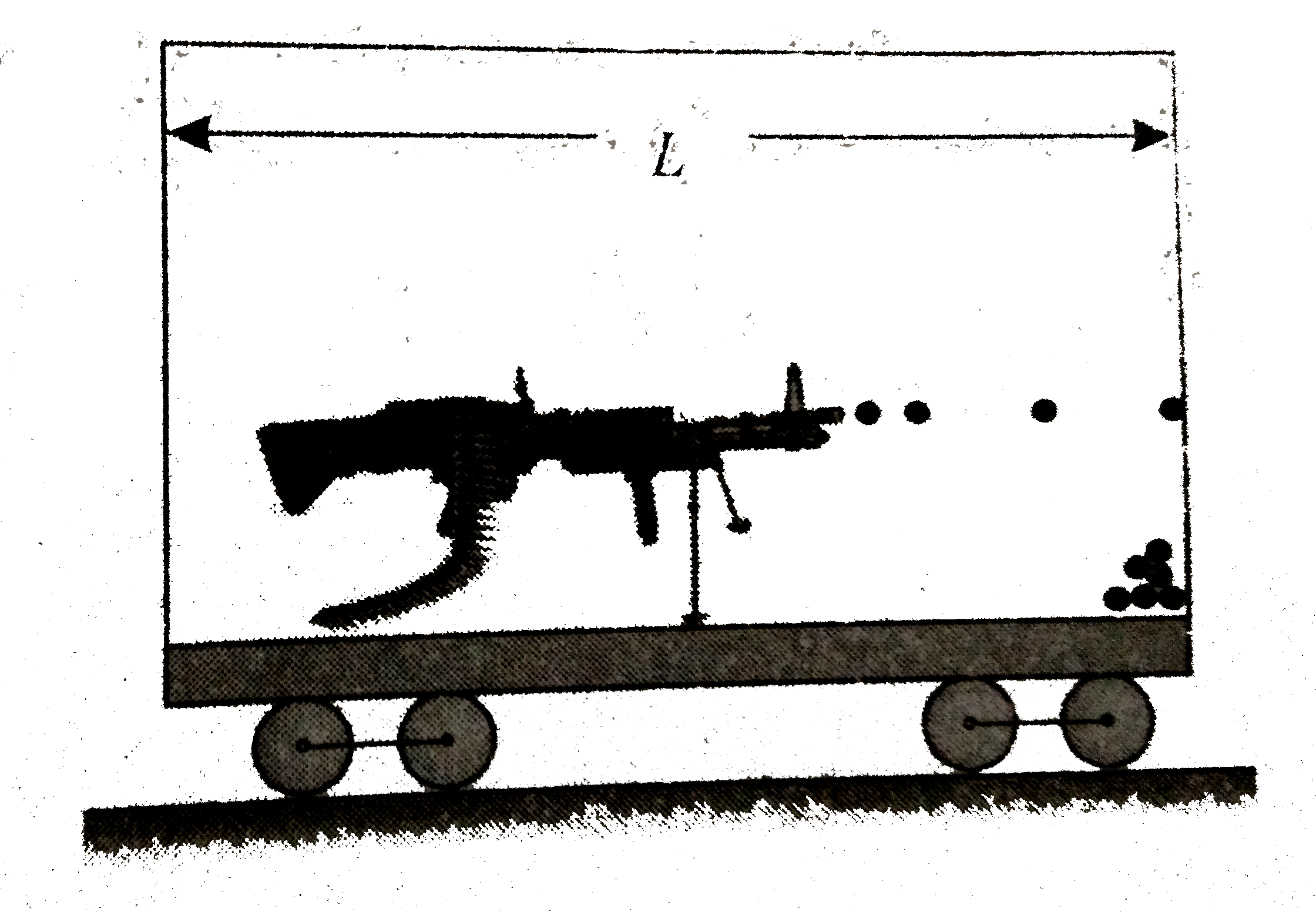
View SolutionA jet airplane is travelling at `200 ms^(-1)` . The engine of the plane takes in 250 `m^(3)` of air of mass 32 kg each second . The air is used to burn 3 kg of fuel each second . The energy is used to compress the products of combustion to eject them at the rear of the plane at `500 ms^(-1)` relative to the plane . Find the power of the jet plane in H.P.(1 H.P = 746 W).
[Hint : Resultant thrust = forward thrust - backward thrust and power = force `xx` velocity ]
View SolutionSand drops from a stationary hopper at the rate of 5 kg `s^(-1)` on to a conveyor belt moving with a constant speed of `2 m s ^(-1)` . What is the force required to keep the belt moving and what is the power delivered by the motor moving the belt ?
[ Hint: Tangetial force exerted on the belt = `u_("rel") (dM)/(dt)` where `u_("rel")` is the tangential relative velocity of the sand .]
View SolutionA right-angled triangular block of mass M rests on a horizontal table . The inclination of the block is `30^(@)` with the table . A cubical block of mass m is placed on the incline of the block . What horizontal force must be applied on M so that m may remain stationery relative to the block ?
[Hint: Apply d' Alember's principal and consider free-body diagrams of m and the system ( m+ M).]
View SolutionA rocket expels mass at the rate of `mu` kg /s at the exhaust speed u . Find the instantaneous acceleration if its initial mass were `M_(0)` kg ?
View SolutionA wedge of mass M rests with one face in contact with horizontal , smooth surface . A particle of mass m is placed on the smooth face on it , inclined at an angle `alpha`to the horizontal and released . Find the velocity of the wedge and that of the particle relative to the wedge when the particle has slipped a distance x down the face of the wedge . Also calculate the acceleration of the wedge and that of the particle relative to the wedge and the smooth surface .
[Hint : Apply principal of conservation of momentum along the horizontal and energy conservation principle . See Example 8 )
View SolutionTwo identical buggies 1 and 2 with one man in each move without friction due to inertia along the parallel rails toward each other. When the buggies get opposite each other, the men exchange their places by jumping in the direction perpendicular to the motion direction. As a consequence, buggy 1 stops and buggy 2 keeps moving in the same direction, with its velocity becoming equal to v. Find the initial velocities of the buggies `v_1` and `v_2` if the mass of each buggy (without a man) equals M and the mass of each man m.
View SolutionTwo identical buggies move one after the other due to inertia (without friction) with the same velocity `v_0`. A man of mass m rides the rear buggy. At a certain moment the man jumps into the front buggy with a velocity u relative to his buggy. Knowing that the mass of each buggy is equal to M, find the velocities with which the buggies will move after that.
View SolutionAssuming that the car in problem 12 is initially at rest and holds n men, each of mass m, prove that if the men run with relative velocity `v_(rel)` and jump in succession they can impart to the car a greater velocity than if they all run and jump simultaneously.
[Hint : When the men run together, the effect is the same as for one man of mass nm.
`:.Delta v=(nm)/(M+nm)v_(rel.)`
When they run and jump in succession,
`Deltav = sum_(i=1)^(i=n) =(mv_(rel))/(M+im)=mv_(rel)((1)/(M+m)+(1)/(M+2m)+(1)/(M+3m)+...+(1)/(M+nm))`]
View SolutionFind an expression for, the acceleration and speed of a trolley A under the action of a constant force F if it contains sand that pours out through the floor at the rate of `mu` per second. The speed of the trolley at t=0 was v=0 and the initital mass of sand and trolley was `M_(0)`
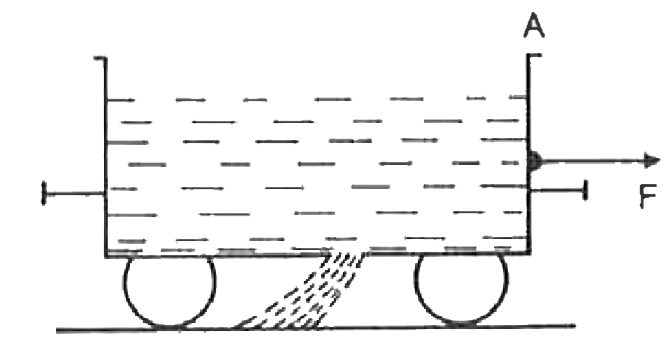
View SolutionTwo masses P and Q are connected by the arrangement shown inFigure 5.19. Find the downward acceleration of the mass Q.
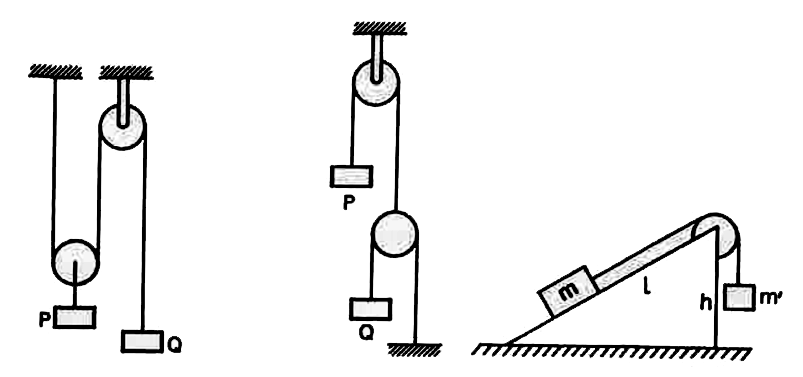
View SolutionNeglecting friction and the mass of the pulleys, find the acceleration of the mass Q assuming that P=Q (Figure 5.20).
View SolutionA body of mass m is drawn up a smooth inclined plane (Figure 5.21) of height h and length l by means of a string passing over the vertex of the plane. From the other end of the string hangs a mass m'. Show that in order that m may just reach the top of the plane, m' msut be deteched after m has moved through a distance `(m+m')/(m')(hl)/(h+l)`
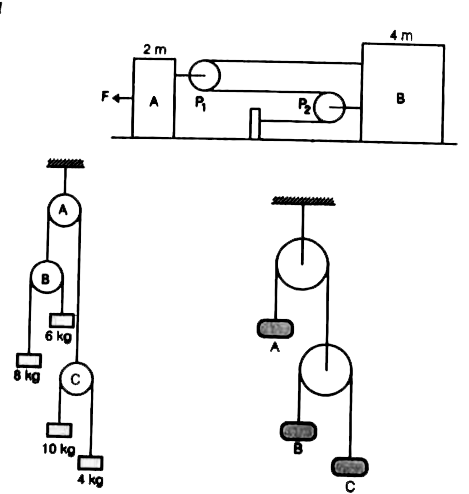
View SolutionCalculate the accelerations of the pulleys B and C and the tension in the string passing over the pulley A of the figure Figure 5.22.
View SolutionCalculate the acceleration of the block B of the figure Fig. 5.23, assuming surfaces and pulleys to be smooth.
View SolutionA system of masses and pulleys is arranged in a vertical plane as shown in Figure 5.24 her. If `m_(A) : m_(B):m_(C)`=3:2:1. Find their accelerations.
View SolutionTwo monkey of masses 10 kg and 8 kg are moving along a verticle rope as shown in fig. the former climbing up with an acceleration of `2 ms^(-2)`, while the later coming down with a uniform velocity of `2 ms^(-1)`. Find the tension in the rope at the fixed support.
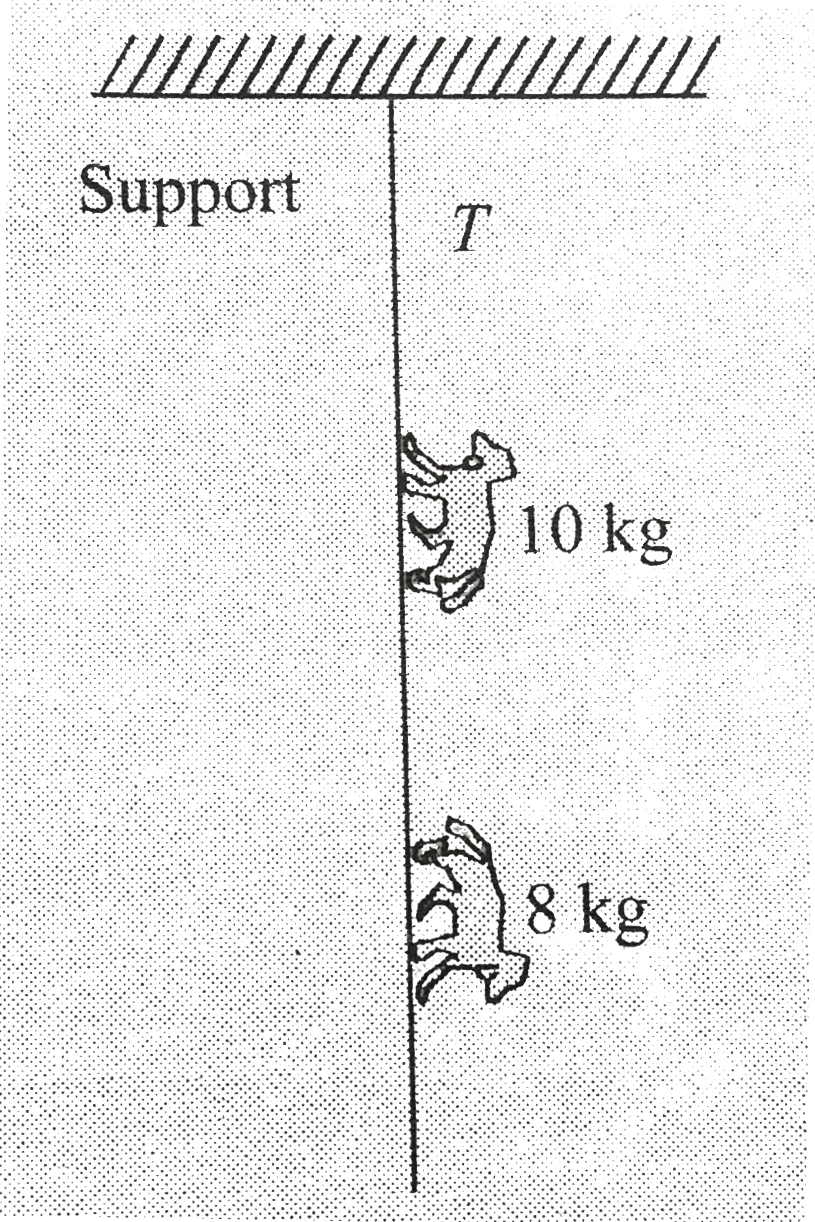
View SolutionA rope is stretched between two stationary boats on the surface of a lake. A man in the first boat pulls the rope with a constant force of 100 N. The distance between the boats is 100 m in the beginning. The mass of the first boat with the man is 250 kg ,while the mass of the other is 500 kg. Find :(i) the velocity of approach of the two boats 15 s after the start,(ii) the time taken for the two boats to meet each other. [Hint: Consider relative acceleration and apply kinematic equations.]
View SolutionA thin, uniform chain is hanging vertically and its bottom end is touching a table . The mass of the chain is m and its length is l . At the moment t=0, the chain is released. Calculate the force that the chain exerts on the table after t seconds.
View SolutionA mass M attached to the end of a small flexible rope of diameter d=1 cm is raised vertically by winding the rope on a reel. If the reel is turned uniformly ay the rate of n=2 rps, what will be the tension T in the rope? Neglect inertia of the rope and slight lateral motion of the suspended mass. (Fig.5.25)

View SolutionA sphere of mass `m_(1)`collides with a sphere of mass `m_(2)` which is at rest. Prove that whatever be the initial direction of the first sphere, it will move off at right angles to the line of centres at the time of collision if the coefficient of restitution is `m_(1)//m_(2)`.
View SolutionTwo equal smooth sphere of radius a are moving with equal speed u in opposite directions along parallel lines which are a distance a apart. The coeficient of restitution between them is 1/3.Find their velocities after impact.
View SolutionA simple pendalum is suspended from a peg on a verticle wall . The pendulum is pulled away from the well is a horizental position (see fig) and released . The bell his the well the coefficient of resitution being `(2)/(sqrt(5)`

what is the miximum number of colision after which the amplitube of secillections between less that `60` digree ?
View SolutionA small metal ball falls vertically and strickes a smooth plane inclined at an angle `theta` to the horizontal `(theta lt 45^(@))`. The ball rebounds horizontally. Show that a fraction (l-e) of the kinetic energy is lost during the impact and that if m is the mass and `mu` the speed of the ball before impact, the impulse on the plane is `mu sec theta`. Here e isi the coefficient of restitutuon.
View SolutionA body projected at an angle `alpha` to the horizontal lands at the same point after hitting a verticle wall. This time it makes an angle `beta` with the horizontal. Show that `e tan beta=tan alpha` where e is the coefficient of restitution between the body and the wall.
View SolutionA small body slides from a height h down a smooth plane inclined at `45^(@)` to the horizontal. How will the body move if at the end of the plane it encounters (a) a completely elaatic plane, (b) an inelastic but smooth plane.
View SolutionA ball is projected from a given point with velocity u at some angle with the horizontal and after hitting a vertical wall returns to the same point. Show that the distance of the point from the wall must be less than `(eu^2)/((1+e)g)`, where e is the coefficient of restitution.
View SolutionA particle of mass `1.0g` moving with velocity `v_1=3.0i-2.0j` experiences a perfectly inelastic collision with another particle of mass `2.0g` and velocity `v_2=4.0j-6.0k`. Find the velocity of the formed particle (both the vector v and its modulus), if the components of the vectors `v_1` and `v_2` are given in the SI units.
View SolutionA ball moving translationally collides elastically with another, stationary, ball of the same mass. At the moment of impact the angle between the straight line passing through the centres of the balls and the direction of the initial motion of the striking ball is equal to `alpha=45^@`. Assuming the balls to be smooth, find the fraction `eta` of the kinetic energy of the striking ball that turned into potential energy at the moment of the maximum deformation.
View SolutionThe masses of A,B and C in the figure (Fig. 5.24) are `m_(A)`=4 kg, `m_(B)`=2 kg and `m_(C)`=3 kg. The mass of the movable pulley is 1 kg. Show that the acceleration of A is `(9g)/(49)`
View SolutionTo raise a weight which is half as much again as his weight a man fastens a rope to it and passes over a smooth pulley, he then climbs up the rope with an acceleration `(6g)/(7)` relative to the rope. Show that the weight rises with acceleration `(8)/(7)`, and find the tension of the rope.
View SolutionA hoop of mass M and radius R is placed on an absolutely smooth level surface. An insect of mas m begins to alight along the hoop from the highest point with speed v relative to the hoop. Find the velocity of the centre of the hoop aftert.
View SolutionA chain of length l and mass m is lumped over the hole in a horizontal plate and a short length hangs down the hole when the chain is at rest. If it is released from this position find the velocity when the last link of the chain leaves the hole.
View Solution
Exercise (B) questions and complete solutions for chapter LAWS OF MOTION, FREE BODY DIAGRAM of BHARATI BHAWAN PHYSICS (HINGLISH) of Class 11